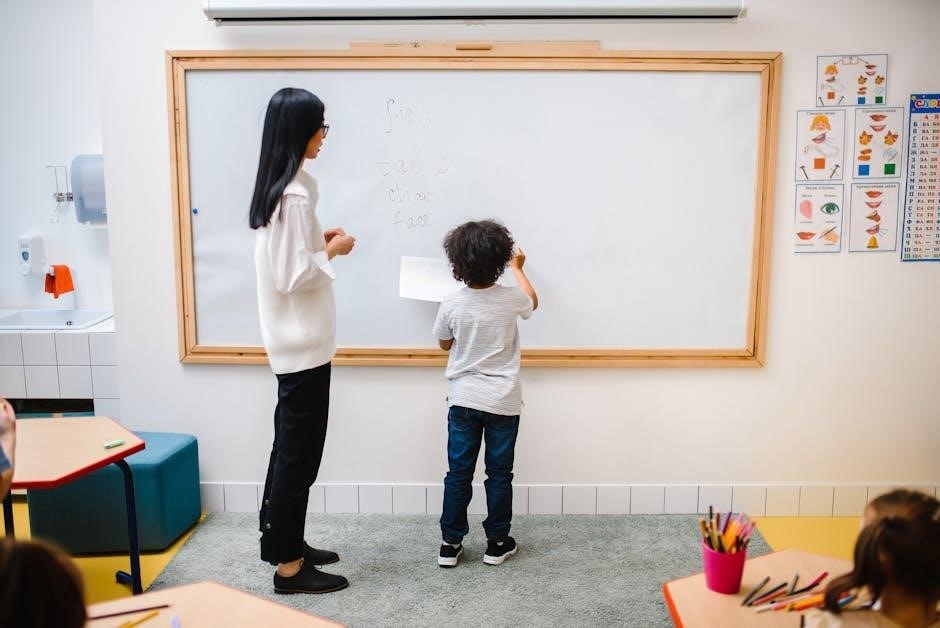Differentiated alphabet knowledge instruction tailors teaching to meet individual student needs, ensuring each learner progresses at their own pace. It involves assessing prior knowledge, incorporating varied learning styles, and using targeted strategies to support skill development. This approach fosters early literacy skills and addresses diverse learning needs effectively.
Importance of Alphabet Knowledge in Early Education
Alphabet knowledge is a foundational skill that plays a critical role in early education, serving as the building block for reading and writing abilities. Research indicates that accurate and automatic recognition of letters is a strong predictor of reading success, as it supports the alphabetic principle. Early literacy experiences vary significantly among children, leading to differences in their alphabet knowledge development. Understanding the sounds, names, and forms of letters enables students to decode words, spell, and comprehend text effectively. Moreover, studies by Piasta and Wagner (2010) emphasize that alphabet knowledge is essential for future academic skills. Therefore, prioritizing its development ensures students are well-prepared for lifelong learning. Differentiated instruction strategies are vital to address these varied needs, ensuring all learners receive targeted support.
Why Differentiation is Crucial in Teaching Alphabet Skills
Differentiation is essential in teaching alphabet skills because it addresses the diverse learning needs of students. Each student enters the classroom with varying levels of knowledge and learning abilities, making a one-size-fits-all approach ineffective. Differentiation allows teachers to assess individual student progress and tailor instruction accordingly, ensuring that those who already know the letters are not bored, while those struggling receive adequate support. This approach can involve grouping students by knowledge level and providing targeted activities, incorporating technology for personalized learning, and engaging different learning styles—visual, auditory, or kinesthetic. Regular assessments help teachers monitor progress and adjust instruction, creating a responsive learning environment where all students can build a strong foundation in alphabet knowledge.
Understanding Differentiated Instruction
Differentiated instruction is a student-centered approach that tailors teaching methods to meet diverse learning needs, styles, and abilities. It ensures engagement and progress for all learners.
Definition and Key Principles of Differentiated Instruction
Differentiated instruction is a student-centered approach that tailors teaching methods to meet diverse learning needs, styles, and abilities. It emphasizes flexibility, allowing teachers to adapt content, processes, and products to ensure all students engage and progress. Key principles include assessment-guided practices, flexible grouping, and varied instructional strategies. Teachers use pre-assessments to identify students’ strengths and gaps, informing targeted instruction. Learning environments are inclusive, fostering engagement and addressing individual differences. Differentiated instruction promotes equity by ensuring all learners have access to meaningful opportunities for growth, regardless of their starting points or learning styles.
Benefits of Differentiated Instruction for Diverse Learners
Differentiated instruction offers numerous benefits for diverse learners by addressing individual needs and fostering inclusive learning environments. It ensures that students with varying readiness levels, learning styles, and abilities receive tailored support. This approach enhances engagement, as learners encounter content that aligns with their interests and strengths. Differentiated instruction also promotes equity, providing opportunities for all students to succeed, regardless of their starting points. By catering to diverse needs, it helps build confidence and motivation, particularly for struggling learners, while challenging advanced students to grow further. Ultimately, differentiated instruction creates a dynamic classroom where every student feels valued and supported in their unique learning journey.
Assessment-Guided Differentiated Instruction

Assessment-guided differentiated instruction uses data to tailor teaching strategies, addressing individual skill gaps and ensuring targeted support for each student’s alphabet knowledge development.
Assessing Students’ Current Alphabet Knowledge
Assessing students’ alphabet knowledge is crucial for differentiated instruction. Teachers use various methods, such as observational checks, letter naming tasks, and sound identification exercises, to evaluate each student’s skills. Formative assessments, like monitoring progress during activities, help identify strengths and gaps. Summative assessments, such as quizzes or letter recognition tests, provide a clear picture of mastery. These evaluations focus on skills like naming uppercase and lowercase letters, identifying sounds, and recognizing letters in words. By understanding each student’s current knowledge, educators can tailor instruction to meet individual needs, ensuring targeted support and fostering foundational literacy skills effectively.
Using Assessment Data to Inform Instructional Decisions
Using assessment data effectively ensures targeted and impactful instruction. Teachers analyze results to identify individual strengths, gaps, and learning needs. This data guides the creation of small, differentiated groups and tailored activities. For example, students struggling with letter recognition receive extra support, while advanced learners engage in challenging tasks. Instructional materials, such as manipulatives or technology, are selected based on student needs. Progress monitoring and adjustments to instruction ensure continuous growth. By leveraging assessment insights, educators maximize learning outcomes, fostering a personalized approach that addresses diverse skill levels and promotes mastery of alphabet knowledge.

Strategies for Differentiating Alphabet Instruction
Differentiated alphabet instruction involves small groups, tiered activities, and technology integration to cater to diverse learning needs, ensuring personalized and effective skill development for all students.
Small Group Instruction for Targeted Skill Development
Small group instruction is a powerful strategy for differentiating alphabet knowledge, allowing teachers to tailor lessons to specific skill levels. By grouping students with similar abilities, educators can address individual needs through targeted activities. This approach ensures that learners receive personalized attention and practice, fostering mastery at their own pace. Research shows that small group instruction is more efficient than whole-class or individual teaching methods, as it allows for focused skill development. Activities such as phonemic awareness exercises, letter recognition games, and guided letter formation practice can be adapted to meet the unique needs of each group. This method also encourages active participation and engagement, making it an effective way to support diverse learners in achieving alphabet knowledge goals.
Tiered Activities to Meet Varying Student Needs
Tiered Activities to Meet Varying Student Needs
Tiered activities are a key component of differentiated instruction, allowing teachers to cater to diverse skill levels within the classroom. By designing tasks at varying levels of complexity, educators ensure that all students, from emerging to advanced learners, are challenged appropriately. For example, foundational activities might focus on letter recognition and naming, while more advanced tasks could involve word building or writing simple sentences. This approach promotes engagement and ensures that no student is left behind or bored. Tiered activities also encourage personalized learning, enabling teachers to monitor progress and adjust instruction to meet individual needs effectively. This strategy supports equitable learning opportunities for all students.
Integrating Technology for Personalized Learning Paths
Integrating technology into alphabet instruction offers personalized learning paths tailored to individual student needs. Educational apps, interactive games, and adaptive software provide engaging ways for students to practice letter recognition, formation, and sound association at their own pace. These tools often include assessments that track progress and adjust content accordingly, ensuring each student receives targeted support. For example, apps can focus on uppercase and lowercase letters for emerging learners or advance to word-building activities for more skilled students. Technology also allows teachers to monitor progress and intervene when necessary, fostering a dynamic and responsive learning environment. This approach enhances engagement and ensures equitable access to learning opportunities.

Supporting Diverse Learning Styles
Supporting diverse learning styles involves using visual, auditory, and kinesthetic approaches to engage students and cater to their individual preferences, enhancing alphabet knowledge retention effectively.

Visual, Auditory, and Kinesthetic Approaches to Alphabet Learning
Visual learners benefit from letter cards, videos, and digital games, while auditory learners thrive with songs, rhymes, and phonemic awareness activities. Kinesthetic learners engage through hands-on tasks like tracing letters or using manipulatives. Combining these approaches ensures all students can access alphabet knowledge in ways that align with their learning preferences. For example, using puppets to introduce letters adds novelty and engages auditory learners. Meanwhile, hands-on activities like letter formation with playdough cater to kinesthetic learners. By integrating these methods, teachers create a differentiated and inclusive learning environment that supports diverse needs and enhances retention of alphabet skills. This multi-sensory approach is particularly effective for young children and struggling learners.
Hands-On Activities and Manipulatives for Engaged Learning
Hands-on activities and manipulatives are essential for engaging students and reinforcing alphabet knowledge. Tools like letter tiles, magnetic letters, or sand trays allow students to explore and interact with letters physically. For example, tracing letters in shaving cream or forming them with playdough enhances kinesthetic learning. Manipulatives such as letter sorting games or puzzles help students recognize and sequence letters. These activities cater to diverse learning styles, making them ideal for differentiation. They also promote active participation, fostering a deeper understanding of letter forms and sounds. By incorporating manipulatives, teachers create a tactile and interactive learning environment that motivates students and supports retention of alphabet skills in a fun and meaningful way.

Addressing the Needs of Struggling and Advanced Learners
Addressing the needs of struggling and advanced learners involves using assessments to identify skill levels and providing targeted support or challenges, ensuring all students grow.
Strategies for Students with Emerging Alphabet Knowledge
For students with emerging alphabet knowledge, systematic and scaffolded instruction is essential. Introduce letters gradually, using visual aids like flashcards or letter tracing to build recognition. Incorporate hands-on activities, such as manipulatives or letter formation exercises, to engage kinesthetic learners. Use puppets or storytelling to make learning fun and interactive. Assess progress regularly to identify gaps and provide targeted support. Small group instruction allows for personalized attention, while technology tools offer interactive and self-paced learning opportunities. Connecting letters to sounds and meaningful contexts, like students’ names, enhances retention. Consistent practice and positive reinforcement help build confidence and foundational skills for future reading success.
Challenging Activities for Students with Advanced Skills
For students with advanced alphabet skills, challenging activities are essential to deepen their knowledge and engagement; Introduce complex letter patterns, such as less common letter combinations or advanced phonetics. Encourage creative projects, like designing alphabet books or creating stories using specific letter sets. Technology tools can provide interactive puzzles or games that require critical thinking. Tiered assignments allow advanced learners to explore letter-sound relationships in depth or analyze letter usage in literature. Providing opportunities for peer teaching or mentoring reinforces their skills while fostering leadership. These activities ensure advanced students remain challenged and motivated, progressing beyond basic alphabet recognition into higher-level literacy skills. Regular assessments help tailor instruction to their growing abilities.
Differentiated alphabet instruction significantly impacts student outcomes by tailoring learning to individual needs, enhancing engagement, and fostering literacy growth. It ensures all students, regardless of skill level, achieve success and foundational reading skills for future academic success.
The Impact of Differentiated Instruction on Student Outcomes
Differentiated alphabet instruction significantly enhances student outcomes by addressing individual learning needs, fostering academic growth, and improving literacy skills. By tailoring instruction to diverse learners, educators ensure that all students, from those with emerging skills to advanced learners, make meaningful progress. This approach boosts confidence, engagement, and overall mastery of alphabet knowledge, which is foundational for reading and writing. Research highlights that differentiated instruction leads to improved academic performance, as it aligns teaching strategies with students’ unique strengths and challenges. Ultimately, it creates a supportive learning environment where every student can thrive and develop the essential skills needed for long-term success in literacy.

Future Directions in Differentiated Alphabet Instruction
Future directions in differentiated alphabet instruction emphasize integrating technology and adaptive learning tools to create personalized learning paths. Educational technology offers interactive and engaging ways to cater to diverse learning styles, allowing real-time data collection to refine instruction. Hands-on activities and manipulatives will continue to play a key role, as they promote active learning and deeper understanding. Additionally, incorporating cross-curricular connections, such as linking alphabet knowledge to early writing and reading skills, will enhance its relevance. Professional development for educators will focus on leveraging these tools effectively, ensuring all students benefit from tailored instruction. This approach promises to make differentiated instruction more accessible and impactful for future learners.





